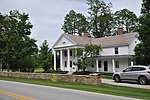Hildene
1905 establishments in VermontBiographical museums in VermontBuildings and structures in Manchester, VermontGeorgian Revival architecture in VermontGilded Age mansions ... and 7 more
Historic house museums in VermontHouses completed in 1905Houses in Bennington County, VermontHouses on the National Register of Historic Places in VermontLincoln familyMuseums in Bennington County, VermontNational Register of Historic Places in Bennington County, Vermont

Hildene, the Lincoln Family Home is the former summer home of Robert Todd Lincoln and his wife Mary Harlan Lincoln, located at 1005 Hildene Road in Manchester Center, Vermont.
Excerpt from the Wikipedia article Hildene (License: CC BY-SA 3.0, Authors, Images).Hildene
Hildene Road,
Geographical coordinates (GPS) Address Website External links Nearby Places Show on map
Geographical coordinates (GPS)
| Latitude | Longitude |
|---|---|
| N 43.140277777778 ° | E -73.079444444444 ° |
Address
Hildene Main House
Hildene Road 1005
05254 (Manchester)
Vermont, United States
Open on Google Maps







